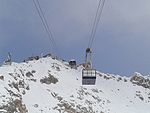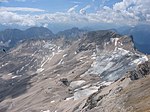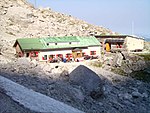Schneefernerhaus

The Schneefernerhaus is a former hotel in the Alps, that is now used as an environmental research station. It lies immediately below the summit of the Zugspitze at a height of 2,650 m and was opened on 20 January 1931. It used to house the top station of the Bavarian Zugspitze Railway as well as a tourist hotel. There was then a cable car from the Schneefernerhaus to the Zugspitze summit. In 1938 a gallery for pedestrians was opened from the ridge station of the Tyrolean Zugspitze Cable Car to the Schneefernerhaus. From 1945 to 1952 the hotel was commandeered for use as a "recreation facility" by the US Forces. On 15 May 1965 an avalanche, that swept over the sun terrace of the hotel and the lifts on the Zugspitzplatt, claimed 10 lives and injured 21. This tragedy was the impetus behind the introduction of a state avalanche warning service and local avalanche commissions. In 1988, after the new station of the Zugspitze Railway was opened on the plateau and, in 1989, the SonnAlpin restaurant there was extended, the hotel and restaurant operation at the Schneefernerhaus finally closed on 14 January 1992. The trackage of the Zugspitze Railway is still there but is now only used to serve the research station.
Excerpt from the Wikipedia article Schneefernerhaus (License: CC BY-SA 3.0, Authors, Images).Schneefernerhaus
Geographical coordinates (GPS) Address Website External links Nearby Places Show on map
Geographical coordinates (GPS)
| Latitude | Longitude |
|---|---|
| N 47.416604 ° | E 10.979589 ° |
Address
Umweltforschungsstation Schneefernerhaus
5
82475
Bavaria, Germany
Open on Google Maps










